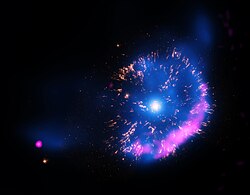Stars/Nova-likes/Quiz
Appearance
< Stars | Nova-likes

Nova-like stars is a lecture about an entity, source, and/or object observed using radiation astronomy.
You are free to take this quiz based on nova-like stars. Once you've read and studied it, the links contained within, listed under See also, External links and the {{stars resources}} template, you should have adequate background to score 100 %.
Suggestion: Have the lecture available in a separate window.
Enjoy learning by doing!
Quiz
[edit | edit source]
Hypotheses
[edit | edit source]- Stars that emit light do so because they are receiving electron irradiation.
- Nova-like activity in stars may be due to a larger star companion.
See also
[edit | edit source]External links
[edit | edit source]- NASA/IPAC Extragalactic Database - NED
- The SAO/NASA Astrophysics Data System
- SIMBAD Astronomical Database
